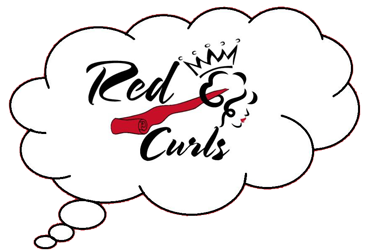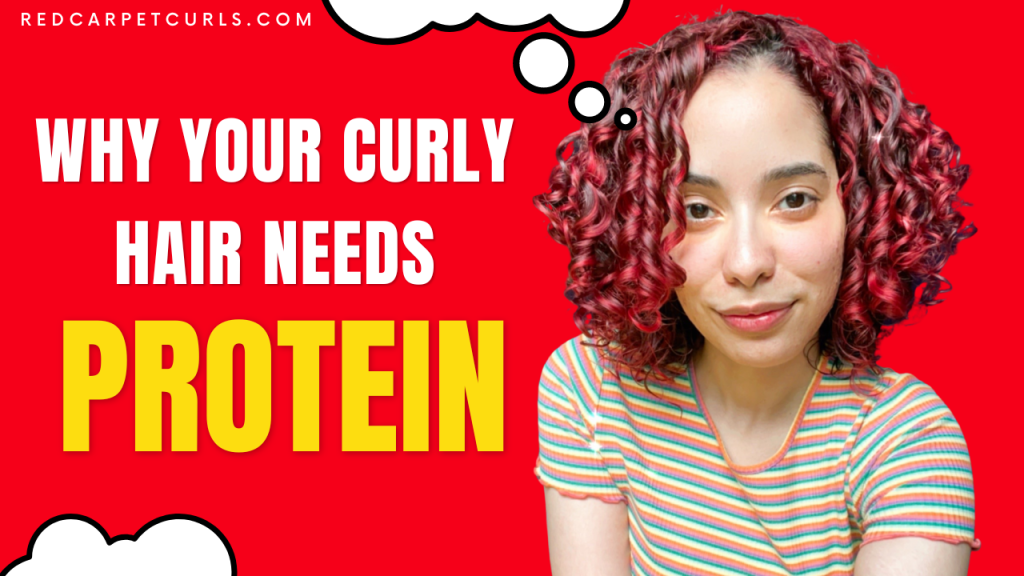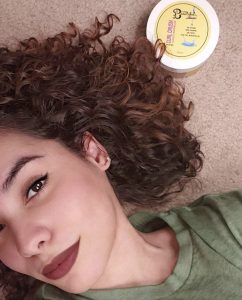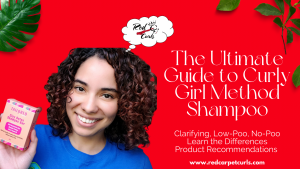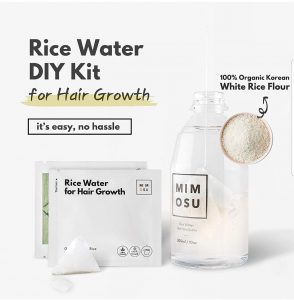What is Protein?

Protein is an essential micronutrient that aids in bodily processes such as hair growth. Protein is made up of even smaller building blocks called Amino Acids. Protein is found throughout the body, inside and out!
Fun Fact: According to Encyclopedia Britannica, the human body is made up of approximately sixteen percent protein.
Our hair strands are technically dead fibrous cells, so it makes complete sense that you need protein to maintain your healthy tresses.
Why Does Curly/Textured Hair Need Protein?

The simplest answer? There is no hair without protein.
According to Milady Cosmetology Textbook, Hair is made up of approximately 91% protein. Protein gives the hair strands structure, providing a physical space to absorb and retain moisture, color, etc.
Think of your protein-based hair strands as individual containers for moisture. If your “container” is full of holes then all the moisture you just imparted will leak right out. Protein acts as a temporary spackle to repair any damage the hair strands have sustained to keep it healthy, vibrant, and strong.
Healthy hair requires a balance between moisture and protein levels in your hair. Remember the old phrase, “too much of a good thing becomes a bad thing”? Well, natural haircare follows the same logic.
Bombarding your hair with moisture treatments and products will overload your hair causing something called Hygral Fatigue (water damage to the cuticle as a result of over-moisturizing your hair).
On the opposite side of the spectrum if you add too much protein to your hair like making sure protein is in every single step and product in your washday, then you can overdo that and send your hair into something called Protein Overload (the hair becomes stiff to the touch since too much protein robs the strands of elasticity and manageability).
This is why we call it a Moisture/Protein Balance. Trust me it seems a lot harder than it truly is once you put this information into action.
In my personal experience, one of the keys to moisture/protein balance is your deep conditioner! Since I recommend deep conditioning weekly, you will deep condition four times during any given month. Alternate your protein-based conditioners with your moisture-based one. If week one you used a protein-based deep conditioner, use a moisture based one for week two. Alternate again the following week. This will help you keep a consistent balance.
The other key to mastering your protein/moisture balance is using the right kind of protein.
What Type Of Protein Does Curly/Textured Hair Need And How Often?

Take a single hair strand between your fingers right now. Feel how small it is in comparison to your fingers. Our hair strands are small and fragile, therefore our protein needs to be small and gentle.
The only type of protein that should ever be used on natural hair is Hydrolyzed Protein. This is just fancy wording for protein molecules that have been broken down to be so small that they can actually penetrate the hair strands.
That’s right, I’m sorry to break it to you but that is why those mayo and avocado masks might make your hair shiny for a bit but it won’t do much to repair your hair effectively. That is because egg proteins are just too big on a molecular level to penetrate the hair strand. Instead they sit on top of the Cuticle (outermost layer of the hair strand, the layer we discuss when talking about porosity) layer.
While Avocado is rich in fatty acids the molecular structure is just too big to penetrate the hair. This is why I suggest using Avocado Oil when looking to add these nutritious fatty acids to your routine. The only reason these foods work when eaten is because the body has already done the work of breaking down these proteins and nutrients.
Hydrolyzed protein has been broken down to be so small and gentle that it can penetrate past the cuticle layer all the way to the deepest layer of the hair, also known as the Cortex.
The Cortex layer is responsible for over 90% of the overall structure and integrity of your hair strands. When you choose proteins small enough to penetrate to this layer of the hair, you will effectively repair your hair in less time. Strengthening the hair strand from the inside out will guarantee protection from split ends, breakage, and any other forms of weathering (damage).
When it comes to the use of hydrolyzed protein remember they are gentle, so if you are utilizing them in your deep conditioning treatments you can use them weekly, or alternate for bi-monthly. If you have stylers that contain protein, remember it will be less concentrated than the deep conditioner so you can use these throughout the week. If you have transitioning hair, you can deep condition (with heat) twice a week.
How To Identify Hydrolyzed Protein On Product Labels

When it comes to proteins you apply externally onto your hair you should always look for Hydrolyzed Proteins on the labels. Common hydrolyzed proteins include:
- Hydrolyzed Wheat Protein
- Hydrolyzed Soy Protein
- Hydrolyzed Silk Protein
- Hydrolyzed Milk Protein
- Hydrolyzed Keratin Protein
- Hydrolyzed Collagen Protein
- Hydrolyzed Quinoa Protein
- Hydrolyzed Rice Protein
- Cocodimonium Hydroxypropyl Hydrolyzed Casein
- Cocodimonium Hydroxypropyl Hydrolyzed Collagen
- Cocodimonium Hydroxypropyl Hydrolyzed Hair Keratin
- Cocodimonium Hydroxypropyl Hydrolyzed Keratin
- Cocodimonium Hydroxypropyl Hydrolyzed Rice Protein
- Cocodimonium Hydroxypropyl Hydrolyzed Silk
- Cocodimonium Hydroxypropyl Hydrolyzed Soy Protein
- Cocodimonium Hydroxypropyl Hydrolyzed Wheat Protein
- Cocodimonium Hydroxypropyl Silk Amino Acids
- Hydrolyzed Oat Flour
- Potassium Cocoyl Hydrolyzed Collagen
- TEA-Cocoyl Hydrolyzed Collagen
- TEA-Cocoyl Hydrolyzed Soy Protein
How to Incorporate Protein Into Your Hair Care Routine

By far the best way to incorporate protein into your haircare routine is by incorporating it in your everyday diet. Remember, we are what we eat. So, that means I’m trying to become less McDonald’s and more Leafy Green these days (I can’t live without my large fries)! Unfortunately, those French fries and nuggets do nothing to further my hair goals. So, I made changes, and so should you!
When looking for protein rich food to eat, look for things like Lean Meats (beef, lamb, veal, etc.), Poultry (chicken, turkey, duck, etc.), Fish/Seafood (clams, lobster, fish, etc.), Dairy Products (milk, Greek yogurt, cottage cheese, etc.) and Nut/Nut Pastes (almonds, Pinenuts, sesame seeds, etc.). Don’t forget your Legumes and Beans like lentils, chickpeas, and tofu!
Your body will break down these proteins and distribute them throughout the body, first to the organs/processes that need it most.
That means your hair may not get most of that protein, which is why we supplement it with protein in our haircare products. Remember what I said about protein/moisture balance? That’s why I gave you the deep conditioning tip. The easiest way to slowly incorporate protein into your hair care routine.
Product Recommendations That Contain Protein

If you need more protein try incorporating styling products that contain protein, I am a big fan of the following products
- Inahsi Naturals Define & Shine Volumizing Foam. This particular product contains Hydrolyzed Rice Protein which is known to increase hair volume, shine, and temporarily repair any gaps/holes in the cuticle layer of the hair. Not to mention this weightless foam always plumps up my curls for a juicy final result. Especially perfect to fight frizz and flyaways. You can save money when ordering using my discount code: REDCARPETCURLS
- Mirabel Naturals Protein Powerhouse Cream which contains Hydrolyzed Wheat Protein and Hydrolyzed Rice Protein. Hydrolyzed Wheat Protein is known to be lightweight and volumizing, improving the appearance of the hair, and penetrating deep into the hair strand to repair any damage to increase moisture retention.
- Ecoslay Matcha Boost Conditioner is a hugely underrated gem in the curly hair community! While this isn’t exactly a styler, it is still worth the mention! This rinse out conditioning treatment contains quinoa protein which is known to be one of the most versatile proteins working for every hair type. It improves the vibrancy of your hair color while improving your moisture retention levels providing beautiful definition and bounce! I tried this conditioner when my hair was at its longest. Fine hair typically has volume issues when growing out but this conditioner just made my curls POP! So much bounce, shine, and definition I was absolutely in love! I mean just look at that photo!
- If you are looking for a strong hold gel that can double as an all-in-one styler, then check out the Be My Curl Let’s Get Kinky Hydrating Gel. This gel not only adds insane shine, moisture and definition, it contains amino acids like Valine, Proline, Threonine, Isoleucine, Histidine, Phenylalanine. Remember what I said about gentle protein? Well, it doesn’t get any gentler than amino acids. Amino acids are the building blocks that compose protein. These amino acids present in the gel will immediately penetrate the hair, improve moisture retention, shine, and definition. You can always save money when ordering Be My Curl products by using the discount code: REDCARPETCURLS17
Protein Recommendations to Add to Your Products

If you cannot tolerate strong smells like that of Liquid Amino Acids you can get with an old hairdresser secret Neutral Protein Filler Drops. It is a clear unscented blend of hydrolyzed proteins focused on gently repairing and increasing the vibrancy of your hair color. I like to add a few drops to my deep conditioner. You can check out my YouTube Tutorial Below.
If you need to add just a little more protein to your regime to make your curls pop, remember you can always ADD hydrolyzed protein to your deep conditioning treatments. For example, my High Porosity hair LOVES protein, seriously, can’t get enough. So, I like to add 1-2 teaspoons of Bragg’s Liquid Amino Acids to my heated deep conditioning treatments to give my curls an extra boost. You can check out my YouTube Tutorial Below.
What About Protein Sensitivity?

Protein sensitivity is super rare, oftentimes, using the wrong type of protein can mimic protein sensitivity. Let’s not forget that using intensive protein like DIY Gelatin Treatments or Aphogee Treatments. These types of treatments are designed for heavily damaged hair like hair transitioning from relaxers. Please remember these are often far too overwhelming for light daily damage, especially if you follow the Curly Girl Method and do not acquire heavy damage.
To truly test if your hair is protein sensitive, remove all products that contain protein from your regime for a few days. Then, on freshly cleansed hair, try a single protein-based product on a small section. If the section of hair becomes dry, brittle, and stiff. Then you are indeed protein sensitive.
Research the benefits of different hydrolyzed proteins to see which one would work best for your current curl concerns.
If you have Low Porosity hair, remember essentially you have healthy hair so you don’t need huge amounts of protein in your regime. At the same time, this doesn’t mean you can go without hydrolyzed protein. All hair needs supplemented hydrolyzed protein because all hair encounters damage. You just need the right protein for your hair.
